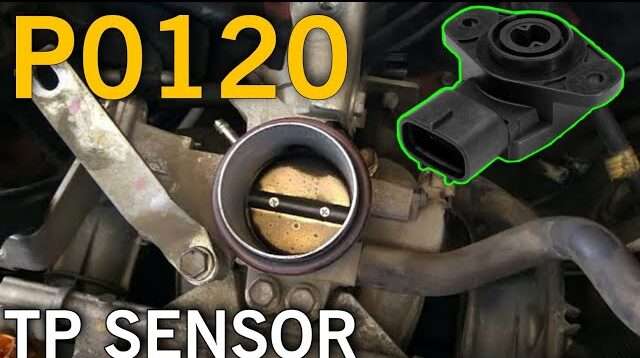
P0120 Throttle Position Sensor Circuit Malfunction
Content
P0120 – OBD-II Trouble Code Technical Description
Trouble code P0120 is a general trouble code that indicates that the Engine Control Module (ECM) has detected that the throttle position sensor A circuit voltage is too low or too high (compared to the manufacturer's specifications).
What does the fault code mean P0120?
Trouble code P0120 is usually associated with problems with the throttle position sensor system. This code indicates an incorrect or missing signal from the throttle position sensor (TPS). The throttle position sensor measures the opening angle of the throttle valve and transmits this information to the engine control module (ECM). When the ECM detects a malfunction or abnormal signals from the TPS, it generates code P0120.

Possible reasons
Some possible causes for the P0120 code:
- Faulty Throttle Position Sensor: The sensor itself may be damaged or malfunction due to wear and tear or other problems.
- Problems with electrical connections: Negative effects on the electrical connections between the throttle position sensor and the ECU may cause signal transmission failure.
- Malfunctions in the power or ground circuit: Problems with the power or ground circuit may cause the throttle position sensor to not operate properly.
- Problems with the throttle mechanism: If the throttle mechanism is sticking or operating erratically, it may cause the P0120 code.
- ECU software: Some problems may be related to the ECU software that processes the signals from the throttle position sensor.
- Problems with wiring or connectors: Damaged wires or connectors connecting the throttle position sensor to the ECU can cause data transmission problems.
For accurate diagnosis and troubleshooting, it is recommended to contact a qualified auto mechanic or car service center.
What are the symptoms of a fault code? P0120?
Some common symptoms that may occur when trouble code P0120 (throttle position sensor) is present:
- Acceleration issues: The vehicle may have difficulty accelerating or respond slowly to the accelerator pedal.
- Uneven engine operation: The engine may run rough at low or variable idle speeds.
- Jerking when moving: If the throttle position sensor is unstable, the vehicle may jerk or lose power when driving.
- Gear shifting problems: Vehicles with automatic transmission may experience irregular shifting or braking.
- Insufficient power: The vehicle may lack power, especially when accelerating hard.
- Errors appearing on the dashboard: In some cases, the “Check Engine” or other warning lights may come on on the dashboard.
If you experience these symptoms, it is recommended that you contact a qualified auto mechanic or auto repair shop to diagnose and repair the problem.
How to diagnose a fault code P0120?
To diagnose trouble code P0120 (throttle position sensor), follow these steps:
- Checking the physical condition of the sensor: Check the condition and position of the throttle position sensor. Make sure it is installed correctly and has no visible damage.
- Checking electrical connections: Check the electrical connections of the sensor for corrosion, oxidation or breaks. Make sure all pins are well connected.
- Using a scanner to read error codes: Use a car scanner to read error codes from the ECU. Check to see if there are other codes besides P0120 that may indicate problems with the sensor or its environment.
- Checking the sensor resistance: Using a multimeter, check the resistance of the throttle position sensor. Compare the measured value with the one specified in the manufacturer's technical documentation.
- Checking the sensor signal: Scan the throttle position sensor signal with a car scanner in real time. Verify that the signal is as expected when changing the throttle pedal position.
- Checking power and grounding: Make sure the throttle position sensor is receiving sufficient power and is properly grounded.
- Checking the throttle mechanism: Check for problems with the throttle mechanism that may be causing incorrect signals from the sensor.
- Checking the ECU software: In some cases, the problem may be related to the ECU software. Updating or reprogramming the ECU may help resolve the problem.
After diagnosing and identifying the cause of the malfunction, it is recommended to carry out the necessary repairs or replacement of components according to the identified problems. If you are not experienced in diagnosing or repairing vehicles, it is recommended that you contact a qualified auto mechanic or auto repair shop for assistance.
Diagnostic errors
When diagnosing trouble code P0120 (throttle position sensor), the following errors may occur:
- Incorrect interpretation of sensor data: Incorrect interpretation of sensor data can lead to erroneous conclusions about its operation. It is important to correctly analyze the signals from the sensor and compare them with the expected values.
- Faulty wiring or connectors: Problems with the wiring or connectors may cause the sensor to malfunction or cause signal loss. Check all electrical connections for corrosion, oxidation, or breaks.
- Malfunction of other system components: Some other engine management system components such as relays, fuses, contacts, etc. can also cause the P0120 code. Check them for functionality.
- Incorrect sensor calibration or installation: Improper calibration or installation of the throttle position sensor may cause the throttle position sensor to read incorrectly. Make sure the sensor is properly installed and calibrated.
- Problems with the mechanical part of the throttle valve: Problems with the throttle mechanism, such as sticking or wear, can cause the sensor to read the position incorrectly.
- Malfunction in the computer: A fault in the Electronic Control Unit (ECU) can also cause P0120. Check the operation of the ECU and its software.
- Insufficient diagnosis: Malfunctions can have multiple causes, and incorrect diagnosis may lead to replacement of unnecessary components. It is important to thoroughly investigate the problem and identify its source.
When diagnosing the P0120 trouble code, it is important to be careful and systematic to avoid the above errors and correctly determine the cause of the problem. If you are unsure of your skills or experience, it is better to contact a qualified technician or auto repair shop for additional assistance.
How serious is the fault code? P0120?
Trouble code P0120, indicating problems with the throttle position sensor, can be serious, especially if ignored for a long time. Here are a few reasons why this code may be considered serious:
- Loss of Engine Control: The throttle position sensor plays an important role in controlling engine performance. If the sensor is not functioning properly, it may result in loss of engine control, which can lead to potentially dangerous situations on the road.
- Loss of power and fuel efficiency: Improper operation of the throttle position sensor can result in loss of engine power and reduced fuel efficiency. This can increase fuel consumption and lead to more expensive repairs in the future.
- Risk of damage to other components: If the throttle position sensor produces incorrect signals, the operation of other engine components may be affected. For example, improper air and fuel management can cause wear or damage to the catalyst.
- Reduced security: If the throttle sensor stops functioning correctly, it may cause you to lose control of the vehicle, especially at low speeds or during maneuvers. This can create dangerous situations on the road and increase the risk of accidents.
So, a P0120 code should be considered serious and requires prompt attention to prevent potential engine safety and stability problems.
What repair will help eliminate the code? P0120?
Fixing a P0120 code may require several steps depending on the specific cause. Some general steps to troubleshoot this problem:
- Checking and cleaning the throttle position sensor (TPS): First check the condition of the throttle position sensor and its connections. Check for corrosion on the contacts or damage to the wiring. If necessary, clean the contacts or replace the sensor.
- Replacing the Throttle Position Sensor (TPS): If the sensor is damaged or defective, it should be replaced. The new sensor must be properly calibrated to ensure proper operation of the engine management system.
- Checking the engine management system (ECM): Sometimes the problem may be with the Engine Control Module (ECM) itself. Check it for defects or damage. If the ECM is truly faulty, it will need to be replaced and reprogrammed to suit your vehicle's specifications.
- Checking vacuum leaks and throttle valve: Incorrect throttle position sensor operation can be caused by vacuum leaks or problems with the throttle body itself. Check for leaks in the vacuum system and the condition of the throttle valve.
- Checking wiring and electrical connections: Bad or broken wires or incorrect electrical connections can cause the P0120 code. Check wiring and electrical connectors for damage and ensure secure connections.
- Diagnostics of other components: Sometimes the problem can be related to other components of the engine management system, such as the oxygen or throttle sensors. Check their operation and replace if necessary.
Keep in mind that resolving a P0120 code may require professional skills and equipment. If you do not have experience in car repairs, it is recommended that you contact a qualified auto mechanic.
P0120 – Brand-specific information
Trouble code P0120 is related to the engine management system and can apply to different makes of vehicles. Here is a list of some car brands and their definitions for the P0120 code:
- Ford: Throttle Position Sensor (TPS) - Low signal output circuit.
- Chevrolet / GMC: Throttle Position Sensor (TPS) / Throttle Position Sensor “A” – Signal Low.
- Toyota: Throttle Position Sensor (TPS)/Signal Output “A” – Signal Low.
- Honda: Throttle Position Sensor (TPS)/Signal Output “A” – Signal Low.
- Nissan: Throttle position sensor (TPS) - low signal.
- BMW: Throttle position sensor (TPS) - low signal.
These are just some of the possible interpretations of the P0120 code for various makes of vehicles. It is recommended that you consult the repair manual for your specific vehicle make and model for more specific information about the P0120 trouble code.

